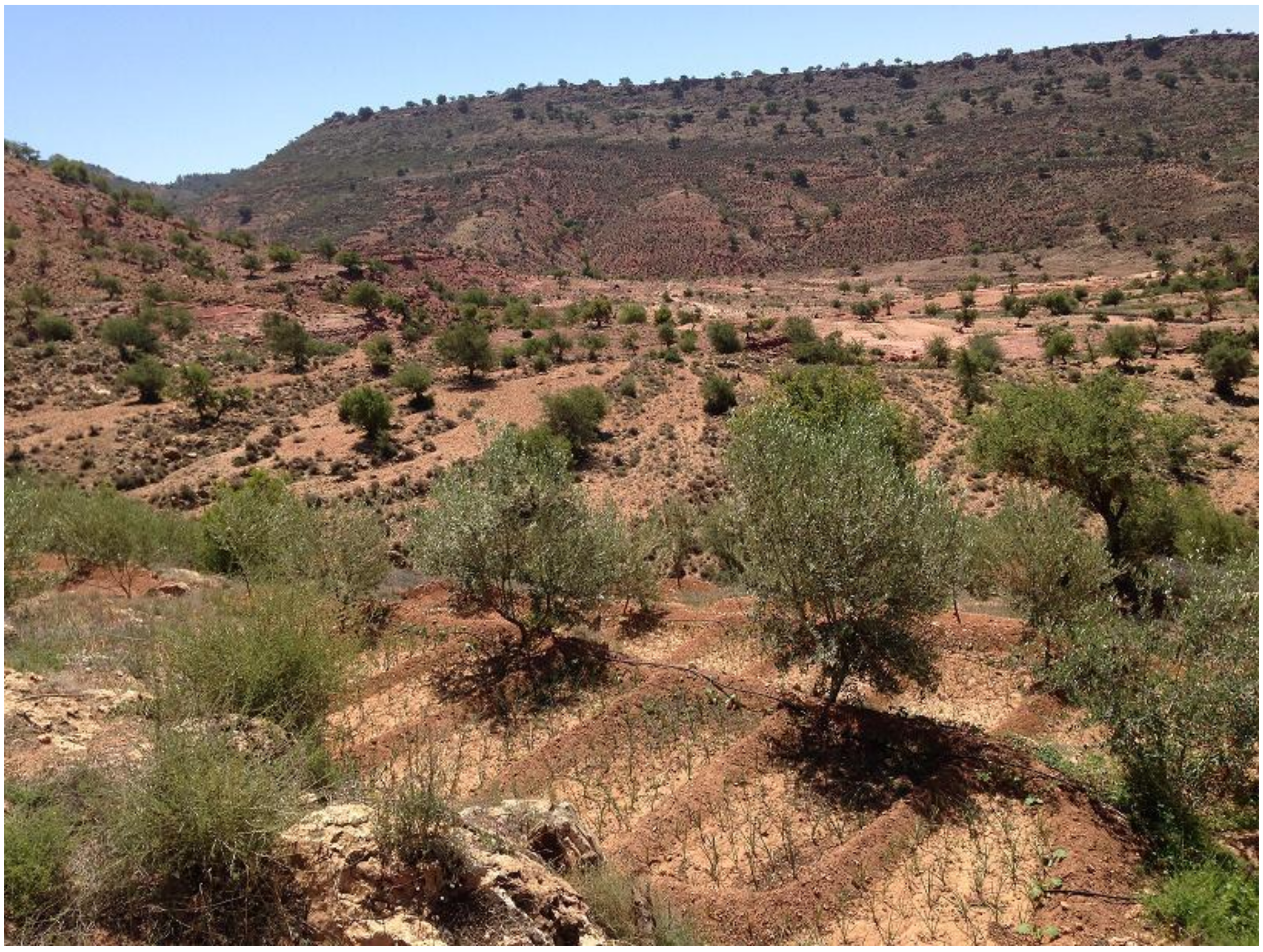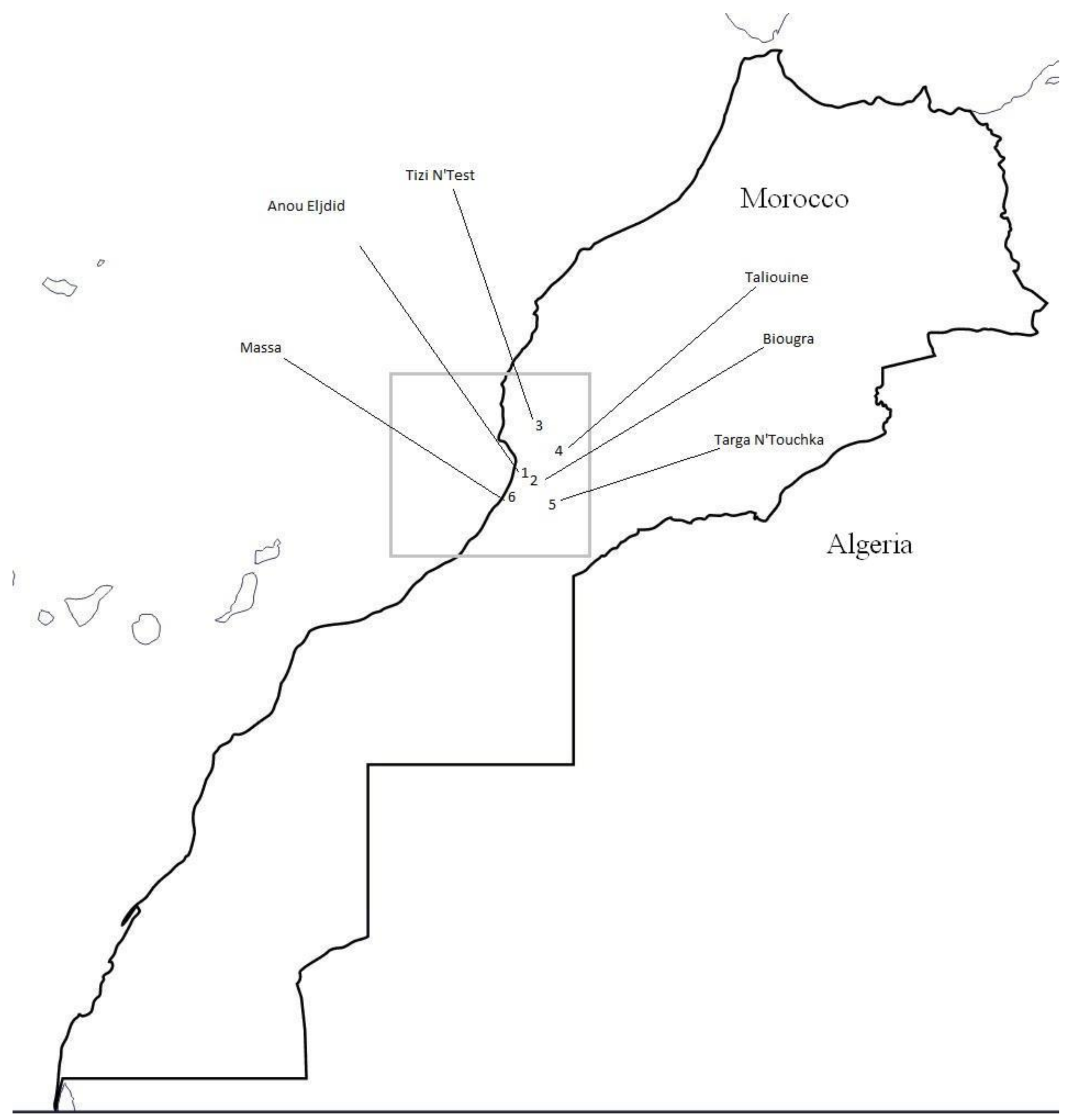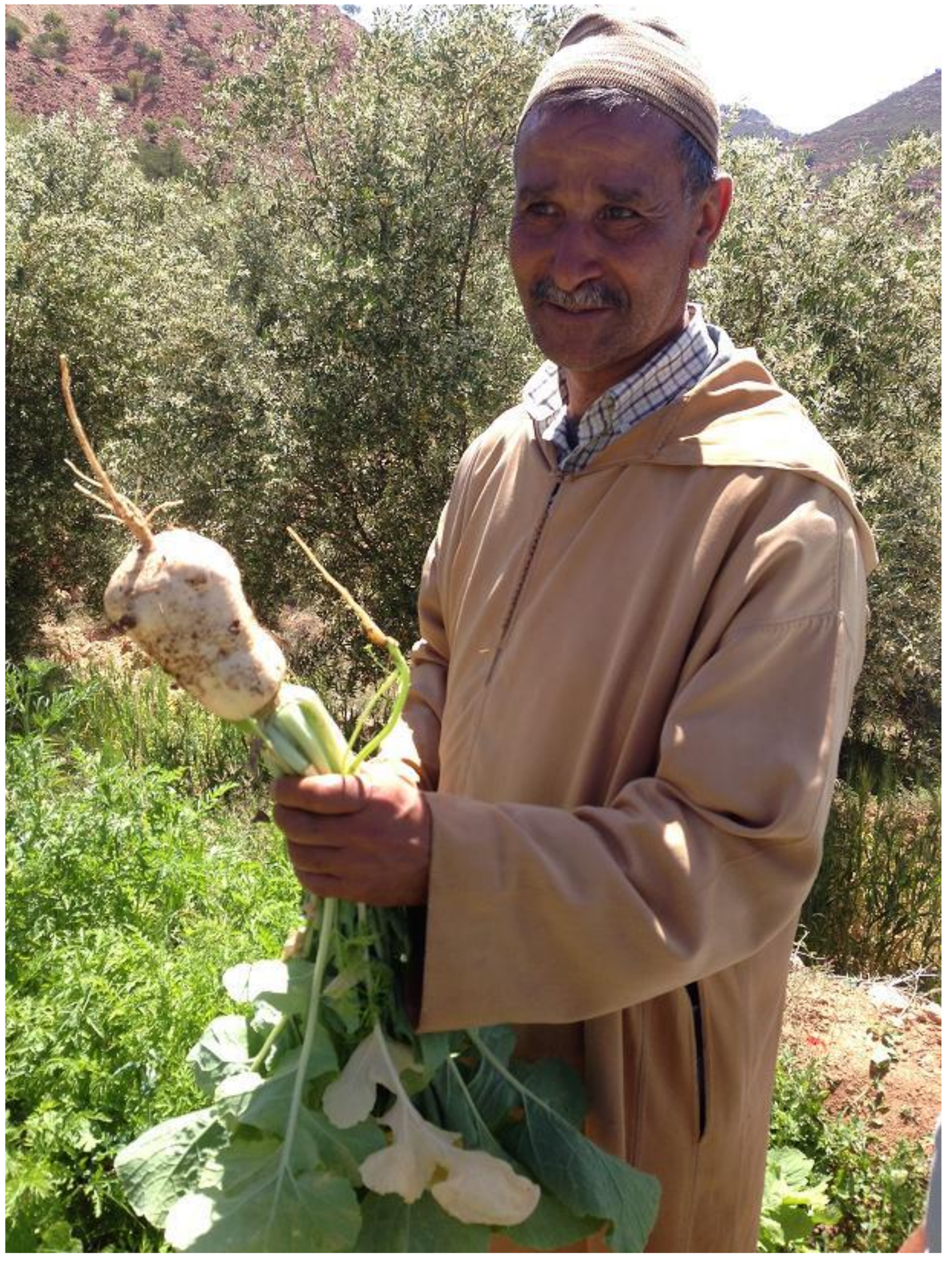The Deterioration of Morocco’s Vegetable Crop Genetic Diversity: An Analysis of the Souss-Massa Region
Abstract
:1. Introduction
2. Materials and Methods
2.1. Study Area
2.2. Vegetable Landrace Assessment and Data Collection
2.3. Data Analysis/Presentation
3. Results
3.1. Farmer Demographics Related to Vegetable Landraces
3.2. Vegetable Crops as Landraces
3.3. Vegetable Crop Landraces Still Grown and Maintained
4. Discussion
4.1. Vegetable Landrace Overview and Importance
4.2. Significant Genetic Erosion and Loss of Vegetable Landraces
4.3. Landraces and Food Security
4.4. Associated Impacts of Green Revolution on Vegetable Landraces
4.5. Improving Landrace Demand in the Local Marketplace
5. Conclusions
Acknowledgments
Author Contributions
Conflicts of Interest
References
- Camancho Vila, T.C.; Maxted, N.; Scholten, M.A.; Ford-Lloyd, B.V. Defining and identifying crop landraces. Plant Genet. Resour. 2005, 3, 373–384. [Google Scholar] [CrossRef]
- Terzopoulos, P.J.; Walters, S.A.; Bebeli, P.J. Evaluation of Greek tomato landrace populations for heterogeneity of horticultural traits. Eur. J. Hortic. Sci. 2009, 74, 24–29. [Google Scholar]
- Morris, M.L.; Bellon, M.R. Participatory plant breeding research: Opportunities and challenges for the international crop improvement system. Euphytica 2004, 136, 21–35. [Google Scholar] [CrossRef]
- Walters, S.A. Vegetable seed availability and implications for developing countries: A perspective from Morocco. Outlook Agric. 2016, 45, 18–24. [Google Scholar] [CrossRef]
- Sangam, D.; Ceccarelli, S.; Blair, M.W.; Upadhyaya, H.D.; Kumar, A.; Ortiz, R. Landrace germplasm for improving yield and abiotic stress adaptation. Trends Plant Sci. 2016, 21, 31–42. [Google Scholar]
- Esquintas-Alcázar, J. Protecting crop genetic diversity for food security: Political, ethical and technical challenges. Nat. Rev. 2005, 6, 946–953. [Google Scholar] [CrossRef] [PubMed]
- Gepts, P. Plant genetic resources conservation and utilization: The accomplishments and future of a societal insurance policy. Crop Sci. 2006, 46, 2278–2292. [Google Scholar] [CrossRef]
- Brush, St.B.; Meng, E. Farmers’ valuation and conservation of crop genetic resources. Genet. Resour. Crop. Evol. 1998, 45, 139–150. [Google Scholar] [CrossRef]
- Khoury, C.K.; Bjorkman, A.D.; Dempewolf, H.; Ramirez-Villegas, J.; Guarino, L.; Jarvis, A.; Rieseberg, L.H.; Struik, P.C. Increasing homogeneity in global food supplies and implications for food security. Proc. Natl. Acad. Sci. USA 2014, 111, 4001–4006. [Google Scholar] [CrossRef] [PubMed]
- Hoisington, D.; Khairallah, M.; Reeves, T.; Ribaut, J.-M.; Skovmand, B.; Taba, S.; Warburton, M. Plant genetic resources: What can they contribute toward increased crop productivity? Proc. Natl. Acad. Sci. USA 1999, 96, 5937–5943. [Google Scholar] [CrossRef] [PubMed]
- Maxted, N.; Guarino, L.; Myer, L.; Chiwona, E.A. Towards a methodology for on-farm conservation of plant genetic resources. Genet. Resour. Crop Evol. 2002, 49, 31–46. [Google Scholar] [CrossRef]
- Frison, E.A.; Cherfas, J.; Hodgkin, T. Agricultural biodiversity is essential for a sustainable improvement in food and nutrition security. Sustainability 2011, 3, 238–253. [Google Scholar] [CrossRef]
- Mavromatis, A.G.; Arvanitoyannis, I.S.; Chatzitheodorou, V.A.; Khan, E.M.; Korkovelos, A.E.; Goulas, C.K. Landraces versus commercial common bean cultivars under organic growing conditions: A comparative study based on agronomic performance and physiochemical traits. Eur. J. Hortic. Sci. 2007, 72, 214–219. [Google Scholar]
- Frankel, O.H.; Brown, A.H.D.; Burdon, J.J. The Conservation of Plant Biodiversity; Cambridge University Press: Cambridge, UK, 1995; 299p. [Google Scholar]
- Walters, S.A.; Groninger, J.W.; Myers, O. Rebuilding Afghanistan’s agricultural economy: Vegetable production in Balkh province. Outlook Agric. 2012, 41, 7–13. [Google Scholar] [CrossRef]
- Evenson, R.E.; Gollin, D. Assessing the impact of the green revolution, 1960 to 2000. Science 2003, 300, 758–762. [Google Scholar] [CrossRef] [PubMed]
- Welch, R.M.; Graham, R.D. A new paradigm for world agriculture: Meeting human needs productive, sustainable, nutritious. Field Crops Res. 1999, 60, 1–10. [Google Scholar] [CrossRef]
- Wood, D.; Lenné, J.W. The conservation of agrobiodiversity on-farm: Questioning the emerging paradigm. Biodivers. Conserv. 1997, 6, 109–129. [Google Scholar] [CrossRef]
- Brush, S.B. The environment and native Andean Agriculture. Am. Indíg. 1980, 40, 161–172. [Google Scholar]
- Negri, V.; Tiranti, B. Effectiveness of in situ and ex situ conservation of crop diversity: What a Phaseolus vulgaris L. landrace case study can tell us. Genetica 2010, 138, 985–998. [Google Scholar] [CrossRef] [PubMed]
- Riu-Bosoms, C.; Calvit-Mir, L.; Reyes-García, V. Factors enhancing landrace in situ conservation in home gardens and fields in Vall De Gósol, Catalan Pyrenees, Iberian Peninsula. J. Ethnobiol. 2014, 43, 175–194. [Google Scholar] [CrossRef]



| Questions: |
|---|
| What are the total number of vegetable growers in your village? |
| What is the percentage of growers cultivating vegetable landraces and saving seed each year in your village? |
| What is the average age of famers cultivating vegetable landraces in your village? |
| What is the estimated percentage of vegetable crop landraces that you think has been lost during the last 30 years? |
| What are the vegetable landraces currently cultivated in your village? |
| Which vegetable crop species landraces have been lost during the last 30 years? |
| Moroccan Souss-Massa Region Village | Total No. of Growers in Village | Percent of Growers Cultivating Landraces and Saving Seed | Farmer Age Cultivating Landraces | Percent Landraces Lost in Last 30 Years |
|---|---|---|---|---|
| Anou eljdid | 8 | 37 | 50 | 80 |
| Biougra | 8 | 25 | 52 | 90 |
| Massa | 15 | 33 | 55 | 90 |
| Taliouine | 13 | 23 | 45 | 80 |
| Targa N’ Touchka | 20 | 45 | 55 | 80 |
| Tizi N’ Test | 10 | 20 | 55 | 90 |
| Moroccan Souss-Massa Region Village | Current Cultivated Vegetable Crop Landraces | Vegetable Crop Landraces Lost within Last 30 Years |
|---|---|---|
| Anou eljdid | carrot (yellow), melon, turnip | carrot, fava bean, melon, pumpkin, watermelon, tomato |
| Biougra | melon, onion, watermelon | melon, tomato |
| Massa | melon, onion, watermelon | tomato |
| Taliouine | carrot (yellow), onion | fava bean, tomato |
| Targa N’ Touchka | carrot (yellow), turnip | melon, watermelon |
© 2018 by the authors. Licensee MDPI, Basel, Switzerland. This article is an open access article distributed under the terms and conditions of the Creative Commons Attribution (CC BY) license (http://creativecommons.org/licenses/by/4.0/).
Share and Cite
Walters, S.A.; Bouharroud, R.; Mimouni, A.; Wifaya, A. The Deterioration of Morocco’s Vegetable Crop Genetic Diversity: An Analysis of the Souss-Massa Region. Agriculture 2018, 8, 49. https://doi.org/10.3390/agriculture8040049
Walters SA, Bouharroud R, Mimouni A, Wifaya A. The Deterioration of Morocco’s Vegetable Crop Genetic Diversity: An Analysis of the Souss-Massa Region. Agriculture. 2018; 8(4):49. https://doi.org/10.3390/agriculture8040049
Chicago/Turabian StyleWalters, Stuart Alan, Rachid Bouharroud, Abdelaziz Mimouni, and Ahmed Wifaya. 2018. "The Deterioration of Morocco’s Vegetable Crop Genetic Diversity: An Analysis of the Souss-Massa Region" Agriculture 8, no. 4: 49. https://doi.org/10.3390/agriculture8040049





